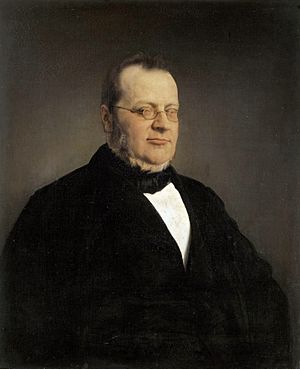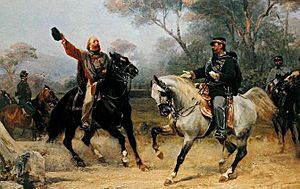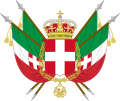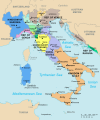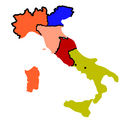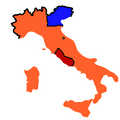Kingdom of Sardinia (1720–1861) facts for kids
Quick facts for kids
Kingdom of Sardinia
Regnum Sardiniae (Latin)
Rennu de Sardigna (Sardinian) Regno di Sardegna (Italian) Regn ëd Sardëgna (Piedmontese) |
|||||||||||||||||
|---|---|---|---|---|---|---|---|---|---|---|---|---|---|---|---|---|---|
| 1720–1861 | |||||||||||||||||
|
Coat of arms
(1833–1848) |
|||||||||||||||||
|
Motto: FERT
(Motto for the House of Savoy) |
|||||||||||||||||
|
Anthem:
S'hymnu sardu nationale
"The Sardinian national anthem" |
|||||||||||||||||

Kingdom of Piedmont-Sardinia in 1859; client state in light green
|
|||||||||||||||||
| Status |
|
||||||||||||||||
| Capital |
|
||||||||||||||||
| Common languages | Since the Iberian period in Sardinia: Sardinian, Corsican, Catalan and Spanish; During the Savoyard period as a composite State: Also Italian (already official in the peninsula since the 16th century via the Rivoli Edict; introduced to Sardinia in 1760), French (official in the peninsula since the 16th century via the Rivoli Edict), Piedmontese, Ligurian, Occitan and Arpitan |
||||||||||||||||
| Religion | Catholicism (official) | ||||||||||||||||
| Demonym(s) | Sardinian | ||||||||||||||||
| Government |
|
||||||||||||||||
| King | |||||||||||||||||
|
• 1720 (first)
|
Victor Amadeus II | ||||||||||||||||
|
• 1849–1861 (last)
|
Victor Emmanuel II | ||||||||||||||||
| Prime Minister | |||||||||||||||||
|
• 1848 (first)
|
Cesare Balbo | ||||||||||||||||
|
• 1860–1861 (last)
|
Camillo Benso | ||||||||||||||||
| Legislature | Parliament | ||||||||||||||||
| Subalpine Senate | |||||||||||||||||
| Chamber of Deputies | |||||||||||||||||
| Historical era | Late modern | ||||||||||||||||
|
• Established
|
1720 | ||||||||||||||||
| 1720 | |||||||||||||||||
|
• Perfect fusion
|
1848 | ||||||||||||||||
|
• Loss of Savoy and Nice
|
1860 | ||||||||||||||||
|
• Became the new Kingdom of Italy
|
1861 | ||||||||||||||||
| Population | |||||||||||||||||
|
• 1821
|
3,974,500 | ||||||||||||||||
| Currency |
|
||||||||||||||||
|
|||||||||||||||||
| Today part of | Italy France Monaco |
||||||||||||||||
The Kingdom of Sardinia was a powerful state in Europe from 1720 to 1861. It brought together the island of Sardinia with other lands owned by the House of Savoy. These lands were mainly in what is now Italy and France.
At first, the Kingdom of Sardinia was like a collection of different states. The island of Sardinia was one part, but the main power and government were in areas like Piedmont and Savoy. Because Piedmont was so important, people often called the state Sardinia-Piedmont or Piedmont-Sardinia.
In 1847, a big change happened called the Perfect Fusion. This made all the different parts of the kingdom into one single, unified country. The Kingdom of Sardinia eventually became the starting point for the modern country of Italy.
Contents
A Look Back: The History of the Kingdom
How the Kingdom Began
The island of Sardinia was once part of the Spanish Empire. But in the early 1700s, after a big war, Spain's lands were divided. In 1720, the island of Sardinia was given to the Duke of Savoy, Victor Amadeus II. He already ruled many lands on the Italian peninsula.
So, the Duke of Savoy became the King of Sardinia. This allowed him to keep the title of "King." His family, the House of Savoy, then ruled the island of Sardinia along with their other lands. These lands included Piedmont, Savoy, and Nice.
The main city and center of power for the kingdom was Turin, in Piedmont. The island of Sardinia itself was important, but the rulers mostly stayed on the mainland.
Changes During the Napoleonic Wars
When Napoleon Bonaparte and France became very powerful, they took over many of the Savoy family's lands on the mainland. For a short time, the King of Sardinia had to live on the island of Sardinia. This was the first time a Savoyard king actually lived there!
The people of Sardinia had their own revolution during this time. They were unhappy with how the mainland rulers treated them. This event, called the Sardinian Vespers, showed their desire for more say in their government.
After Napoleon was defeated, Europe was reorganized. The Kingdom of Sardinia got its mainland lands back. It also gained new territory, including the city of Genoa. This made the kingdom stronger and helped it act as a buffer against France.
A New Constitution and Big Changes
In the 1830s, the Kingdom of Sardinia started to become more modern and industrial. In 1848, a new constitution was created called the Statuto Albertino. This document gave people more rights and set up a constitutional monarchy. This meant the king's power was limited by laws and a parliament.
Also in 1848, the "Perfect Fusion" officially united all the different parts of the kingdom. This made it a single, centralized country with its capital in Turin.
The king at this time, Charles Albert of Sardinia, went to war against Austria. He wanted to unite more Italian lands. But his army was defeated.
Leading the Way to Italian Unity
After Charles Albert, his son Victor Emmanuel II became king. In 1852, a very important leader named Camillo Benso, Count of Cavour became Prime Minister. Cavour was a smart politician who wanted to make the Kingdom of Sardinia strong and unite all of Italy.
The Kingdom of Sardinia even joined the Crimean War alongside countries like Britain and France. This helped them gain respect from other European powers.
In 1859, France helped the Kingdom of Sardinia fight another war against Austria. This war helped Sardinia gain Lombardy, a rich region in northern Italy.
Garibaldi and the Unification of Italy
In 1860, a famous Italian hero named Giuseppe Garibaldi led an army of volunteers, known as "The Thousand." They sailed south and quickly took over the Kingdom of the Two Sicilies, which was a large state in southern Italy.
Garibaldi then handed these lands over to King Victor Emmanuel II. This was a huge step towards uniting all of Italy. However, Garibaldi was a bit disappointed because he wanted Italy to be a republic, not a kingdom. He also wanted to conquer Rome, but Cavour and the king stopped him.
The Birth of the Kingdom of Italy
On March 17, 1861, something truly historic happened. The Parliament of Sardinia officially declared the Kingdom of Italy. The Kingdom of Sardinia had grown so much that it became the new country of Italy!
The laws and government of the Kingdom of Sardinia were then used for all of Italy. Turin remained the capital for a few years, then it moved to Florence, and finally to Rome. The House of Savoy continued to rule Italy until 1946, when Italy became a republic.
How the Kingdom Was Run
Government Structure
Before 1847, the Kingdom of Sardinia was a "composite monarchy." This means the king ruled many different lands, each with its own laws and traditions. The island of Sardinia was just one part, while Piedmont and Savoy were other distinct areas.
The "Perfect Fusion" in 1847 changed this. It made all these different lands into one single country with the same laws. This made the government much more organized and centralized.
The Statuto Albertino, the constitution from 1848, was very important. It set up a system where the king shared power with a parliament. This constitution was so strong that it became the basis for the laws of the new Kingdom of Italy. It lasted until Italy became a republic in 1948.
The main leader of the country was the King of Sardinia. The day-to-day government was run by the Prime Minister.
Military Power
The Kingdom of Sardinia had its own army, called the Royal Sardinian Army, and a navy, the Royal Sardinian Navy. These forces were very important in the wars that led to the unification of Italy. When Italy was formed, these military forces became the new Royal Italian Army and Regia Marina.
Money and Economy
The economy of the Kingdom of Sardinia grew a lot, especially under the leadership of Camillo Benso, Count of Cavour. Cavour believed that a strong economy was needed before big political changes could happen. He was a big fan of building railroads and canals to improve trade and transportation. He also encouraged new farming methods and the use of modern tools.
Currency Used
Before the Napoleonic Wars, the main money used was the Piedmontese scudo. During Napoleon's time, the French franc was used. After the wars, the Sardinian lira became the official currency. This money was used until Italy was unified.
Flags, Royal Standards, and Coats of Arms
When the House of Savoy gained the Kingdom of Sardinia, they needed a flag for their navy. Their old flag was too similar to the Knights of Malta's flag. So, they added things like the letters FERT or a blue border to make it different.
Later, King Charles Albert adopted a new flag. It was the "revolutionary" Italian tricolor (green, white, and red) with the Savoy family's shield on it. This flag later became the flag of the Kingdom of Italy. The tricolor flag without the shield is still the flag of Italy today.
- Coats of arms
- State Flags
- Other Flags
-
War Ensign of the Royal Sardinian Navy (1785–1802)
-
Civil and merchant flag (1851–1861), the Italian tricolore with the coat of arms of Savoy as an inescutcheon
- Royal Standards
Maps
How the Kingdom of Sardinia Grew (1796 to 1860)
-
1859: Kingdom of Sardinia Kingdom Lombardy–Venetia Duchies Parma–Modena-Tuscany Papal States Kingdom of the Two Sicilies
-
1860: Kingdom of Sardinia Kingdom Lombardy–Venetia Papal States Kingdom of the Two Sicilies
After the annexation of Lombardy, the Grand Duchy of Tuscany, the Emilian Duchies and Pope's Romagna. -
1861: Kingdom of Sardinia Kingdom Lombardy–Venetia Papal States
After the Expedition of the Thousand.
See also
 In Spanish: Reino de Cerdeña (1720-1861) para niños
In Spanish: Reino de Cerdeña (1720-1861) para niños
- List of monarchs of Sardinia
- List of viceroys of Sardinia
- Spanish Empire
- S'hymnu sardu nationale
- Kingdom of Sardinia (1324–1720)
- Kingdom of Sardinia (1700–1720)




